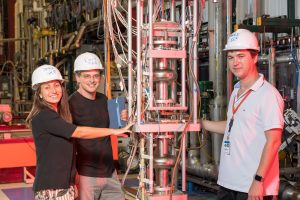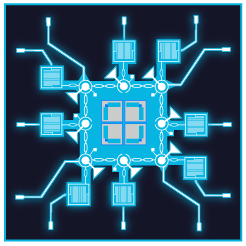
The U.S. Department of Energy’s Fermilab has been selected to lead one of five national centers to bring about transformational advances in quantum information science as a part of the U.S. National Quantum Initiative, announced the White House Office of Science and Technology Policy, the National Science Foundation and the U.S. Department of Energy today.
The initiative provides the new Superconducting Quantum Materials and Systems Center funding with the goal of building and deploying a beyond-state-of-the-art quantum computer based on superconducting technologies. The center also will develop new quantum sensors, which could lead to the discovery of the nature of dark matter and other elusive subatomic particles. Total planned DOE funding for the center is $115 million over five years, with $15 million in fiscal year 2020 dollars and outyear funding contingent on congressional appropriations. SQMS will also receive an additional $8 million in matching contributions from center partners.
The SQMS Center is part of a $625 million federal program to facilitate and foster quantum innovation in the United States. The 2018 National Quantum Initiative Act called for a long-term, large-scale commitment of U.S. scientific and technological resources to quantum science.
The revolutionary leaps in quantum computing and sensing that SQMS aims for will be enabled by a unique multidisciplinary collaboration that includes 20 partners – national laboratories, academic institutions and industry. The collaboration brings together world-leading expertise in all key aspects: from identifying qubits’ quality limitations at the nanometer scale to fabrication and scale-up capabilities into multiqubit quantum computers to the exploration of new applications enabled by quantum computers and sensors.

“The breadth of the SQMS physics, materials science, device fabrication and characterization technology combined with the expertise in large-scale integration capabilities by the SQMS Center is unprecedented for superconducting quantum science and technology,” said SQMS Deputy Director James Sauls of Northwestern University. “As part of the network of National QIS Research centers, SQMS will contribute to U.S. leadership in quantum science for the years to come.”
At the heart of SQMS research will be solving one of the most pressing problems in quantum information science: the length of time that a qubit, the basic element of a quantum computer, can maintain information, also called quantum coherence. Understanding and mitigating sources of decoherence that limit performance of quantum devices is critical to engineering in next-generation quantum computers and sensors.
“Unless we address and overcome the issue of quantum system decoherence, we will not be able to build quantum computers that solve new complex and important problems. The same applies to quantum sensors with the range of sensitivity needed to address long-standing questions in many fields of science,” said SQMS Center Director Anna Grassellino of Fermilab. “Overcoming this crucial limitation would allow us to have a great impact in the life sciences, biology, medicine, and national security, and enable measurements of incomparable precision and sensitivity in basic science.”
The SQMS Center’s ambitious goals in computing and sensing are driven by Fermilab’s achievement of world-leading coherence times in components called superconducting cavities, which were developed for particle accelerators used in Fermilab’s particle physics experiments. Researchers have expanded the use of Fermilab cavities into the quantum regime.
“We have the most coherent – by a factor of more than 200 – 3-D superconducting cavities in the world, which will be turned into quantum processors with unprecedented performance by combining them with Rigetti’s state-of-the-art planar structures,” said Fermilab scientist Alexander Romanenko, SQMS technology thrust leader and Fermilab SRF program manager. “This long coherence would not only enable qubits to be long-lived, but it would also allow them to be all connected to each other, opening qualitatively new opportunities for applications.”
To advance the coherence even further, SQMS collaborators will launch a materials-science investigation of unprecedented scale to gain insights into the fundamental limiting mechanisms of cavities and qubits, working to understand the quantum properties of superconductors and other materials used at the nanoscale and in the microwave regime.
“Now is the time to harness the strengths of the DOE laboratories and partners to identify the underlying mechanisms limiting quantum devices in order to push their performance to the next level for quantum computing and sensing applications,” said SQMS Chief Engineer Matt Kramer, Ames Laboratory.
Northwestern University, Ames Laboratory, Fermilab, Rigetti Computing, the National Institute of Standards and Technology, the Italian National Institute for Nuclear Physics and several universities are partnering to contribute world-class materials science and superconductivity expertise to target sources of decoherence.

SQMS partner Rigetti Computing will provide crucial state-of-the-art qubit fabrication and full stack quantum computing capabilities required for building the SQMS quantum computer.
“By partnering with world-class experts, our work will translate ground-breaking science into scalable superconducting quantum computing systems and commercialize capabilities that will further the energy, economic and national security interests of the United States,” said Rigetti Computing CEO Chad Rigetti.
SQMS will also partner with the NASA Ames Research Center quantum group, led by SQMS Chief Scientist Eleanor Rieffel. Their strengths in quantum algorithms, programming and simulation will be crucial to use the quantum processors developed by the SQMS Center.
“The Italian National Institute for Nuclear Physics has been successfully collaborating with Fermilab for more than 40 years and is excited to be a member of the extraordinary SQMS team,” said INFN President Antonio Zoccoli. “With its strong know-how in detector development, cryogenics and environmental measurements, including the Gran Sasso national laboratories, the largest underground laboratory in the world devoted to fundamental physics, INFN looks forward to exciting joint progress in fundamental physics and in quantum science and technology.”
“Fermilab is excited to host this National Quantum Information Science Research Center and work with this extraordinary network of collaborators,” said Fermilab Director Nigel Lockyer. “This initiative aligns with Fermilab and its mission. It will help us answer important particle physics questions, and, at the same time, we will contribute to advancements in quantum information science with our strengths in particle accelerator technologies, such as superconducting radio-frequency devices and cryogenics.”
“We are thankful and honored to have this unique opportunity to be a national center for advancing quantum science and technology,” Grassellino said. “We have a focused mission: build something revolutionary. This center brings together the right expertise and motivation to accomplish that mission.”
The Superconducting Quantum Materials and Systems Center institutions include DOE’s Ames Laboratory, Colorado School of Mines, Fermi National Accelerator Laboratory, Goldman Sachs, Illinois Institute of Technology, the Italian National Institute for Nuclear Physics, Janis Research, Johns Hopkins University, Lockheed Martin, NASA Ames Research Center, National Institute of Standards and Technology, Northwestern University, Rigetti Computing, Stanford University, Temple University, Unitary Fund, University of Arizona, University of Colorado Boulder, University of Illinois at Urbana Champaign and University of Padova, Italy.
The Superconducting Quantum Materials and Systems Center at Fermilab is supported by the DOE Office of Science.
Fermilab is supported by the Office of Science of the U.S. Department of Energy. The Office of Science is the single largest supporter of basic research in the physical sciences in the United States and is working to address some of the most pressing challenges of our time. For more information, visit science.energy.gov.















